Wake up friendos; tank combat just got tankier. In the world of Clash of Steel, the new release from Gale Force Nine, it’s 1948 and The War has picked up where it left off – and there’s no room on the battlefield for anything but the biggest, baddest tanks around. Germany, the western Allies and the Soviets have rebuilt their tank armies, and now it’s a fight to the death as the Soviets resume their march across Europe. Operation Unthinkable has begun, and you’re in charge. Clash of Steel imagines a Second World War that never really ended to ask the big question: what if the Wünderwaffen of 1945 had their chance to fight it out?
Here’s a red-hot historical take for you: the longer World War II continued, the more unhinged the tanks became. Year after year, the major powers slapped more armour, bigger guns and sillier names on their tanks until eventually the fighting came to an end and dozens of fantastic projects were mothballed and all but forgotten. The minds that dreamed up the 207-ton Maus traded sanity for steel, and only a rare few of these monuments to bigness ever had their day in the sun. Today we have nothing but blueprints and a few partial or degraded hulls to remember the metal monstrosities that could have been.
Well, Clash of Steel says: no more. Designed with a laser focus on big tanks, bigger battles and near-zero fuel efficiency, this title is an evolution of the venerable Flames of War system that cuts out everything that isn’t tanks hurling man-sized chunks of steel at other tanks. You’ll find no infantry or airpower here, and the only artillery is aimed horizontally. Today, Goonhammer reviews this new title to find out how it looks, how it plays, and whether it has a space on our shelves.
We would like to thank Gale Force 9 for providing us with a copy of the rules to review.
Editors’ Note: We would be remiss if we did not point out that the fictional backstory of Clash of Steel has problematic elements. Its internal logic hangs on the myth of the “Clean Wehrmacht“. This was used by Nazis post-war as a way to distance themselves from the horrors of the Holocaust in whatever way they could. Hence the idea that it was “only the worst of the SS” that were dedicated genocidal Nazis, or that the actions of the SS can be separated from the rest of the Nazi military, economic, political and social machine. The myth launders the actions of the Wehrmacht and rendering them “clean” soldiers who were innocent of the crimes of the Nazi regime. This is impossible. “Ordinary” soldiers took part in warcrimes. The OKW and OKH, including the old Prussian Nobility actively planned and carried out genocide.
Western powers have been actively complicit in propagating both tropes, usually for reasons of political expediency, which, for the record, does not make it OK. These myths are pernicious because they are easy to overlook, especially for those unfamiliar with the subject matter. We point them out because refuting falsehoods based in propaganda is worth doing, even (and perhaps especially) when they have wormed their way into popular cultural consciousness. If you would like to know more about the Clean Wehrmacht myth and its misuse, we recommend The Myth of the Eastern Front by Ronald Smelser and Edward Davies.
What is Clash of Steel?
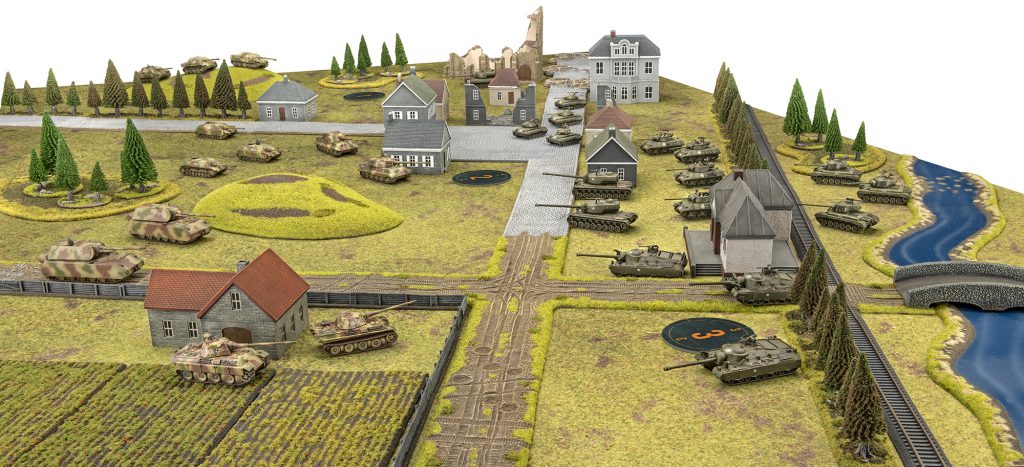
This is a tank combat game, pure, distilled and unadulterated. Grown from the same stock as WWIII: Team Yankee and Flames of War, Clash of Steel strips away everything that isn’t the tanks and then speculates about the evolution of the tank in the immediate post-War period. A quick glance at the box reveals some similarities between this game and other titles like the World of Tanks Miniatures Game – and that’s probably no accident, as they were born under the same roof. Many of these vehicles will already be familiar to you, but under the hood this is the Flames of War system you all know and love; the rulebook has just lost a bit of weight.
At its most basic, both players will design a force of tanks using a points system for balance, then select a mission and fight for victory – you may be slightly familiar with this concept here at Goon Hammer Dot Com. Gameplay boils down to players taking turns to move their vehicles and fire at the enemy, with some administrative steps to resolve the effects of combat. Leaning in to some of Team Yankee’s more “historically inspired” tendencies, the selection of vehicles here isn’t limited by strict historical accuracy – the designers have picked from a wide range of experimental and design-phase vehicles from the late- and post-War periods, and the variety available here is much greater than in pure historical titles.
If the designers were aiming to make Clash of Steel like Flames of War but ‘only the good bits,’ it’s clear that they thought that the best bit of a tank game is the tanks. Everything that isn’t tanks has been surgically excised from the game, and the space this created has been filled with features that add dimension to this narrow focus. Infantry, artillery and airpower are all gone. Given how long and hard it was for us to get to grips with those mechanics in WWIII: Team Yankee, we’re very open-minded about this change. Entire gameplay steps, like Assault, are simply gone because of this change and the result is a much simpler gameplay loop.
The biggest evolution away from Flames of War and Team Yankee (aside from the “no meat allowed sign” on the front door) is the introduction of Mission, Objective, and Tactics cards that change what game you play, how you score it, and what cool tricks each player has to throw a spanner in their opponent’s works. With six basic Mission cards and nine Mission Rule cards, that’s 54 possible mission types without introducing the Objective or Tactics tweaks, and they’re all quite different, changing game length and adding rules like Ambush, Reserves, or Night Fighting.
Objective Cards are Sockbert’s favourite new rule; one random card is placed face down on each objective, with one revealed at the start of each round. These can significantly change the game; some make you want to be careful about committing hard to one objective in case it’s suddenly worthless, while others may change which turns you can score an objective, reduce range of units nearby, or even hide your tanks while you’re contesting it. There are 22 Objective cards, and with each Mission only having two or three objectives each and 54 possible mission combinations, it’ll be a long while before you repeat a game.
If you’ve played Flames of War, you’ll be familiar with a lot of these vehicles, with several of them lifted right out of Late War books. Even if you don’t want to use these new rule cards, many of the miniatures are the same as vehicles in other Flames of War titles. While that’s not true for the whole range, we do think it’s nice that at least a few of these models exist in both games, and there’s nothing stopping you from just taking the new unit cards and slotting them into your Flames of War games.
Controversially, the Reserves rules are still here and broadly unchanged. For those new to Flames of War and Team Yankee, Reserves are a requirement in some missions to withhold deployment of 40% of one or both players’ armies and then deploy them with one or more restrictions on placement and timing. This has always been a little abrasive to us, having played more than one game which felt like the outcome was decided by the Reserves rule, so we’re a little bummed that it’s still here in broadly the same form. On the plus side Deep, Delayed, and Scattered Reserves are gone – a silver lining.
Despite its heritage, Clash of Steel is its own game and it’s clear that the design team intended for the game to be more straightforward, better explained and with more options than its predecessors. We’ll delve into the differences between this title and others in the Flames of War family elsewhere in this review, but you can expect to be fighting more dynamic missions with a simpler ruleset than ever before.
What’s Cool About It?
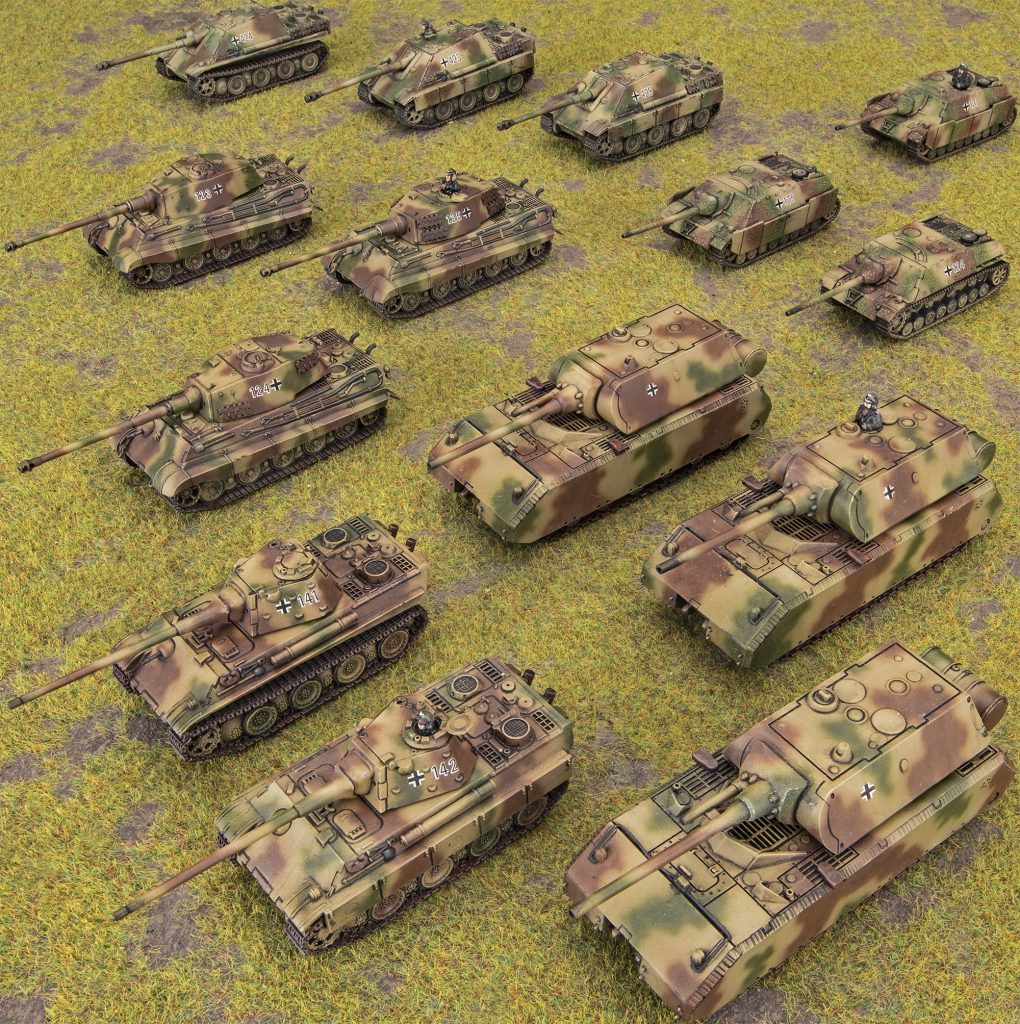
The Tanks! If you’re going to play any tank game, it may as well be the one with the tankiest tanks around. It’s no accident that the selection of vehicles in Clash of Steel bears similarities to the tech trees in World of Tanks miniatures game – aside from sharing a publisher, the offering here absolutely passes the ‘cool’ test. If you’ve ever read that Wikipedia article and wondered, “what if… all Maus?”, then this is your game.
Asking ‘What-If?’ is fun. The alternative history presented in this game lets the designers and players lean hard into their creative side, and we’re intrigued to see how the community embraces the possibilities here. There’s space here for a dynamic narrative, homebrew armies and army-specific rules that would feel out of place or silly in a historical game. Done well, this could breathe life into this game for a long time to come. The designers have already made it clear that any army can play against any other (rather than strict Axis vs Allies of Flames of War) and we hope to see more options for creative play in the future. Operation Unthinkable, the recommencement of hostilities by the Allies against the Soviets the minute World War II ended, never really happened, and it’s not something that other game designers have really explored yet, so this is a unique setting and a nice, blank canvas to fill in. How Unthinkable is your Operation? Quite Thinkable, we hope.
New force construction options. Clash of Steel introduces Commander Abilities, upgrades for HQ units that offer the player more control over their play style. From the simple armour upgrade offered by I Know A Guy to the armour save rerolls of Birth of a Legend (which we think is ridiculously good), players have 25 options that they can buy from the same points pool as their vehicles.
Dynamic mission rules. One of our key criticisms of Team Yankee has been the static feel of objective play, and this game tackles that problem head on. Rather than instant-win conditions, armies play for points that are earned by contesting and controlling objective points, and destroying enemy units. Those objectives will also have their own rules which are revealed gradually during play, which may modify the value of the objective, alter the rules for the mission as a whole, or even apply terrain effects like Low Ground. With 22 of these cards in a shared deck, you’re unlikely to ever play the same exact mission twice.
The easiest Flames of War game to learn. With a rulebook of barely fifty pages including narrative, a quick reference, and the index, you can see needless complexity stripped from almost every game mechanic without any real loss of depth or fun. The rulebook is freshly written, with a clean new layout and a less wordy style, and gameplay has been re-organised with a more logical flow. Overall, this is probably the easiest game in this family for new players to learn.
How does it play?
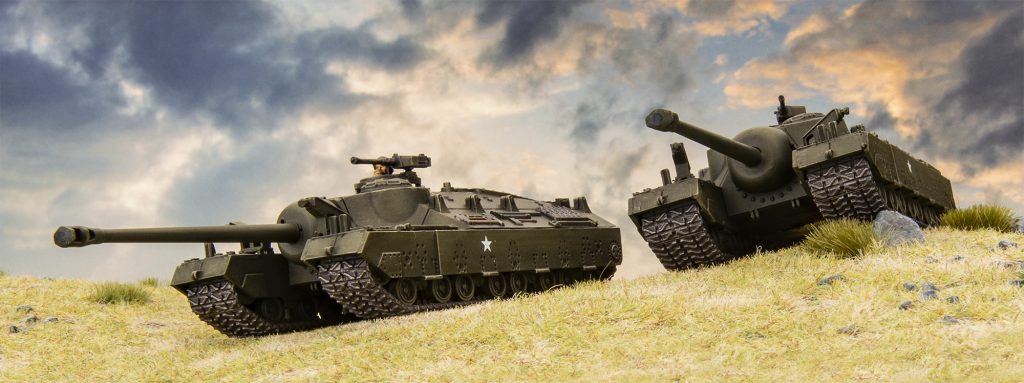
While Clash of Steel tries hard to stand on its own, it still looks and feels like Flames of War and Team Yankee. Let’s run through a few of the major features and how we think they’ll play out.
Army construction is vastly simplified from any other offering in the series. Whereas the Goonhammer team were stumped by the hundred-odd formation types in Team Yankee each with their own dependencies, options and incompatibilities, things are much simpler here – you pick your army, and then you just pick some units. You’ll have one HQ unit, some core units and optionally some support units and that’s it. We think this is a vast improvement in newbie-friendliness.
Armies are also currently limited to nine units in total, much smaller and tighter than any game in its stable, taking one HQ, 2-6 Core Units, and 0-2 Support Units. The average army probably won’t fill out that roster, so we’re probably going to see smaller, tighter forces that will fit in a small carry case. It’s also neat that each army allows you to take Core Units from “other British [or equivalent] forces”. Each of these army lists is an Operation: Unthinkable Force, so this is a solid hint that the developers intend to keep growing out this game with new forces.
And then we get to Commander Abilities. These things have potential to be silly. Unlike most tank units which cannot be upgraded at all (so, so helpful for getting newer gamers into the game), HQ units can receive up to two of the 25 Commander Abilities which are described in the main rule book, and range in cost from one to five points. There is some potential for absolute jank here, and how to handle this incredible power is up to you – we’re not here to judge. Here are two combinations that jumped straight out at us:
- Birth of a Legend (re-roll failed armour saves for the Commander) and I Know A Guy (Front and Side armour improved by 1). In the case of Soviets vs Germans, this allows you to create a Maus Commander that can only be outright destroyed by the ISU-130, and only two other tanks can even bail the crew out (on an armour save roll of 1). Although being Bailed Out can still destroy a unit, Commanders innately reroll these tests too. This makes for one monstrously tough tank to destroy if it can get into a protected position on an objective.
- Custom Ammo (AT rating improved by +2) and Inspiring (after Commander kills a tank, gain one reroll to hit for each tank within 6”) allows the Commander to pick off one relatively easy target and then buff the killing power of every nearby vehicle. In fact, you can replace Custom Ammo with any of several related buffs that add rerolls or allow them to ignore concealment, depending on your budget. Being apparently the only source of rerolls to hit in the game for non-HQ tanks, this combination is
absolutely lethalperfectly reasonable and normal, nothing to see here.
These Abilities make Commanders the centrepiece of the battlefield, and fights are likely to evolve around the actions of the HQ units. While this hardly turns them into unstoppable juggernauts, players will benefit from constructing their armies around the Commander. This is a kind of creativity we think could be really exciting. Fortunately, Commander Abilities don’t transfer to any new tank that the Commander moves to once their original vehicle is destroyed.
The Nations
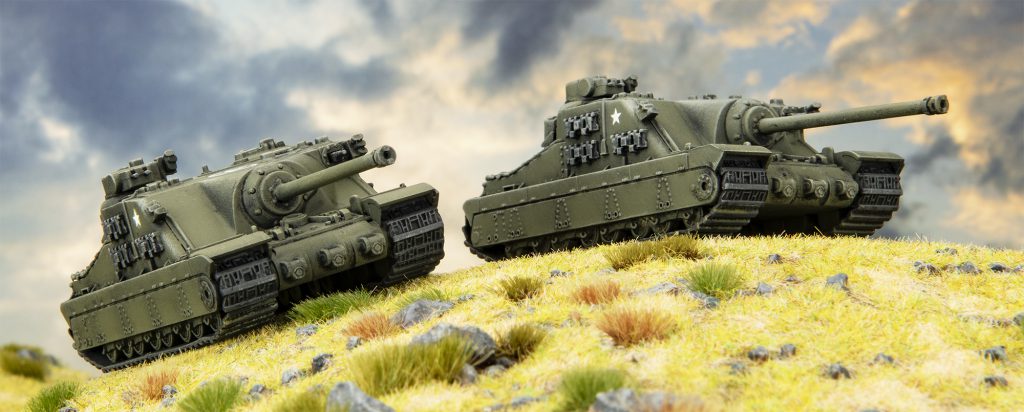
Clash of Steel offers players four powers to play: Americans, British, Germans and Soviets. The best thing about the Nations booklets that describe these faction is just that: they’re booklets with all their rules contained in fewer than 20 pages, with no Codex-style hardcover rulebooks required. Each of the starter sets at release includes a booklet for each of the two Nations it contains, so you can get playing right out of the box. This is a big plus for the accessibility department.
There are two great starter boxes for Clash of Steel, one including Germans and Brits, and the other containing Soviets and Americans. Each force contains between eight and fourteen models, and all are roughly 45 points; enough for half an army with some Commander Abilities to spare. Also, every force is entirely legal! No need to buy fractions of boxes just to play a legal game.
With that said, let’s break down how each of these Nations is going to play and feel.
Americans
If the Soviets can claim that ‘quantity has a quality of its own’, then the Americans say the same about calibre. The Americans absolutely do not mess around when it comes to firepower. We count three separate vehicles which fire AT19 shells, one of which – the mighty T30 – also boasts AUTO firepower and guarantees a kill with every failed armour save. With the average British front armour of 11, German 14, American 13 and Soviet of, uh, 9, the Yanks are not messing around when it comes to punching holes. The Americans are the counter to ultra-heavy armour, but will need to balance the availability of these big guns against the need for smaller, lighter supporting tanks to protect their bigger brothers and, y’know. Be able to move across the table to score points.
In other respects, the Americans find themselves in the middle of the field. They have one excellent superheavy, the T28, which combines high firepower and armour but moves slower than an amendment to the US Constitution. The Assault Pershing also offers quality armour, but with a much lighter weapon, and below these two it’s all fair-to-middling. Similarly, the Americans offer middling Skill and Motivation, and average unit sizes of up to five vehicles. They should be reasonably straightforward to play, and a decent option for new players.
British
If the Americans bring the Big Guns, the British bring flexibility, with some of the heaviest (including the heaviest) tanks in the game combining with a range of medium tanks to put the hurt exactly where you want it. With skills the same as the Americans and similar numbers across the board, you’re probably going to take the British where you want the specific tank, rather than raw power, though they do generally come in a little cheaper. The major challenge with the British is that their unit size is capped at three vehicles (except the Archer, which can have four). This means they will more easily give up Destroyed Unit points to opponents, and so we can probably expect British forces to lean into the superheavies more than average. The restriction also applies an absolute cap of 28 vehicles in a British force, the smallest of any Nation.
Every gun in the British Isles has a Firepower of 3+, and is the only nation in the system to not hit 2+ Firepower at least once. This is… challenging, and though we only got to play a couple of games with the Brits, Sockbert on more than one occasion was slightly miffed (in the proper British fashion) at not being able show Davey’s Germans what-for, pip-pip.
Quick shout out to the Tortoise here, the heaviest (as in armour, not mass – that’s the Maus) tank in Clash of Steel. This thing is a proper brick. The major weakness will be that vehicles with hull-mounted guns can only change their firing arc by 90 degrees each turn, so we anticipate that many games will end with swarms of tiny tanks pantsing a lonely Tortoise and stealing its lunch money. These things need friends. Combining a Tortoise with I Know A Guy from the Commander Abilities selection creates a monstrosity that almost no tank in the game can even scratch. You heathen.
Oh, and the Brits can take a Churchill tank too, which Sockbert stubbornly insists is the sexiest tank known to humankind. Don’t worry, we’ve already referred them to a therapist about this.
Germans
The Germans have a superheavy called Maus, and a superlight called Puma. If that’s not clear evidence of the Prussian sense of humour, we don’t know what is.
German forces are characterised by heavy armour and high skill. In fact the Maus is probably the single reason this game exists, being the poster child for absurd tank design in a world that didn’t have the technology to make it real. It is, in fact, legal to bring an army of naught but seven Mauses, with a spare seven points left over for Commander Abilities. Sockbert was heard to say that this is “very cool and fair” while slowly converting Davey’s soviets to chunky paste in our playtesting. To highlight the extent of this overmatch, an ISU-130, the best gun in the Soviet stockpile, still bounces off the sides on an armour save roll of 6 and only causes a Bail Out on a 5, while being literally unable to hurt the damn thing from the front.
More generally, the Germans have access to consistently high Skill ratings of 3+, competent weapons, and unit sizes of up to five vehicles. They’ll hand off very few Unit Destroyed points to their opponents, but will have the chief problem of managing against outnumbering enemies in almost every game. If any army manages to win after being cleared from the table, it’ll probably be these guys.
Other than armour-based horrors from beyond the ken of man, Germany is unique in being able to take actual wheeled vehicles in the Puma and Sd Kfz 234/4 (pronounced the same as a loud, wet sneeze, presumably). This unit is both Scout and Spearhead, letting you push your army forward in deployment while also dying to a stiff breeze. Seriously, there isn’t a gun in the game that doesn’t automatically penetrate these things, but hey, what do you want? They’re half a point each.
Soviets
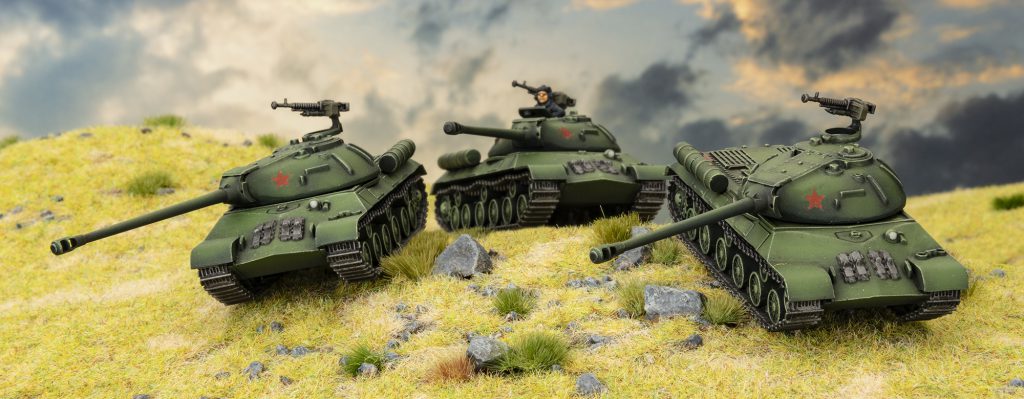
Davey started singing the Monty Python Spam song the moment he saw this force, and try as we might he hasn’t shut up yet. Seriously, you can get a lot of tanks on the table here, but thanks to Clash of Steel’s design you’re still not going to run into the parking lot problems of Team Yankee. This army is, and we cannot stress this enough, trash. But like… useful trash. Look. It’s a Russian thing. You’re investing heavily to the promise that your turrets will blot out the sun, and you’ll have to be brave enough to suffer a lot of dead steel and make proper use of terrain before you get your hordes into the flank of enemy tanks and start ripping them apart.
The biggest drawback here, and one that we’re not sure that the Soviet list can overcome, is that your opponent will score 3 VP for each of your units they destroy; as much as holding an Objective uncontested, and there will be a lot more Soviet units on the table than Objectives. There’s going to come a point where even if you get your survivors into the Germans’ flanks, and even if they can score all the objectives in the world, a Soviet army may just be so far down on points that victory is impossible. That being said, Soviet units can comprise in some cases of ten tanks, so try it out! Maybe they’ll run out of bullets before you run out of dudes.
Aside from volume, Soviets have the universally highest motivation (3+) and lowest skill (5+) in the game. These guys aren’t running away, but it makes Movement Orders a right pain to execute with the exception of Follow Me – allowing you to dash just a little further without firing There’s also nothing in here that could count as a superheavy, like the Maus, Tortoise, or T28; the IS-3 comes in at a measly Front Armour 14 with an AT 14 gun. This doesn’t mean it’s bad, just that it’s playing a different game. On the offensive side, however, the ISU-130 is mighty respectable with AT 18 and FP2 2+; just don’t let it get shot back.
Wrapping It All Up

So where does this leave us? This ain’t your papa’s Flames of War, that’s for sure, and there’s a lot to unpack with this release.
We’re pretty positive about a few features of Clash of War. We’re super chuffed about the accessibility of this release, with a good set of Starter Boxes coming out at release that offer well-reasoned starting armies, simple rules, and the relevant Nations books right there in the box. Your average newbie can just walk home with this game and start playing the moment the miniatures are built. We’re also excited by the Commander Abilities and changes to mission play, which should prevent things from getting stale, and the pseudohistorical context provides some intriguing opportunities for new missions and new stories in the future.
There are also some things that we’re not super keen on. The Reserves rule is here to stay and, while it seems so much less imposing than previous versions, we expect that it might still be pretty brutal in a game where some forces might bring fewer than a dozen vehicles. There’s also an open question of how excited the historical gaming community will be to lay down their planes, templates and infantry stands to embrace an alternative history game that has neither the World War II lived history and shared cinematic universe, nor the more lived history of Team Yankee modernity. The accessibility we’ve mentioned will help here, and the starter boxes will at least provide a pair of good armies, but it’s still to be seen how well this new title forms a community of its own.
Gale Force Nine have clearly decided to spare no part of the game in their efforts to produce a tighter, neater, and more streamlined version of the Flames of War system. We think there’s a lot to like here, and we’re excited to post more about our adventures in 1948. Come join us in Eastern Europe! Er. Again.


